Back to StoriesVirtual Fences: A Promising Tool for Conservation and Ranching
September 9, 2024
Virtual Fences: A Promising Tool for Conservation and Ranching Bozeman workshop and Crazy Mountain project explore potential in virtual fencing technology
by Sophie
Tsairis
Over the
summer, the Property and Environment Research Center and the Beyond
Yellowstone Living Lab
cohosted the largest virtual fencing workshop of its kind in Bozeman, Montana.
The event united experts in technology, agriculture and conservation to explore
this emerging tool’s potential to support conservation and agriculture.
The
revolutionary technology establishes a virtual fence network through a series
of signal towers and GPS collars worn by cattle. The collars produce auditory
and physical feedback to the cows as they approach geo-fenced areas, effectively
managing their movement and keeping them out of certain areas like riparian
habitats or wildlife corridors. According to representatives from the Property and Environment Research Center, a nonprofit
conservation organization based in Bozeman, the technology is proving to hold countless benefits
for ranchers and wildlife conservation.
PERC is currently
partnering with McFarland White Ranch in the Crazy Mountains on a virtual
fencing project, an initiative that includes outfitting the ranch’s 2,000 cows
with GPS collars, setting up six solar-powered signal towers, and replacing 16
miles of the ranch’s traditional barbed wire fencing with virtual fencing.
Barbed wire fences are a key barrier to wildlife
migration throughout the West, and this particular property in the Crazies is
part of a pronghorn migration route.
Montana barbed-wire fences can cost between $15,000 and $20,000 per mile to replace.
Travis Brammer, director of conservation at PERC, told Mountain
Journal how the project began with an interest in the potential for new technology
to solve some of the challenges presented by more conventional methods. “The
rancher came to us interested in virtual fencing when a fire burned down some
of her traditional fencing a couple years ago,” Brammer said.
In addition to the high cost of replacing the burned
fencing—Montana barbed-wire fences can cost between $15,000 and $20,000 per
mile—Brammer said the rancher was interested in virtual fencing to open up the
migration corridor on the property.
The MacFarland project is about a year old, and Brammer
explained that the technology is still emerging. While the project has hit a
few snags along the way, he said it has been successful and has demonstrated
great potential overall.
While
other pilot projects are exploring virtual fencing in the region, this one is
particularly noteworthy for its explicit focus on migratory wildlife conservation
and its impact on agricultural productivity, including economic impact, range
management and livestock benefits.
“This
project is pretty unique to the region,” Brammer said. “It’s one of the only
virtual fencing projects where the priority is to remove barbed wire fences.”
_______________________________________________________________________________________________________________________________
Mountain Journal is a nonprofit, public-interest journalism organization dedicated to covering the wildlife and wild lands of Greater Yellowstone. We take pride in our work, yet to keep bold, independent journalism free, we need your support. Please donate here. Thank you.
Related Stories
August 13, 2024
Nonprofit Sues Montana DEQ Over Gallatin Mine Approval
The Gateway Conservation Alliance filed a lawsuit against Montana citing environmental
concerns over recent amendments to Opencut Mining Act.
February 10, 2025
DEQ Reports Nitrates in Wyoming Community Linked to Septic Systems
After years of nitrate
contamination in Hoback Junction, its residents are still grappling with access
to clean drinking water.
January 10, 2025
Yellowstone and Grand Teton: What’s in a Timed Entry?
While
some national parks are implementing a timed visitor entry to mitigate
congestion, the nation’s first and its 18th are keeping it old
school.
...




